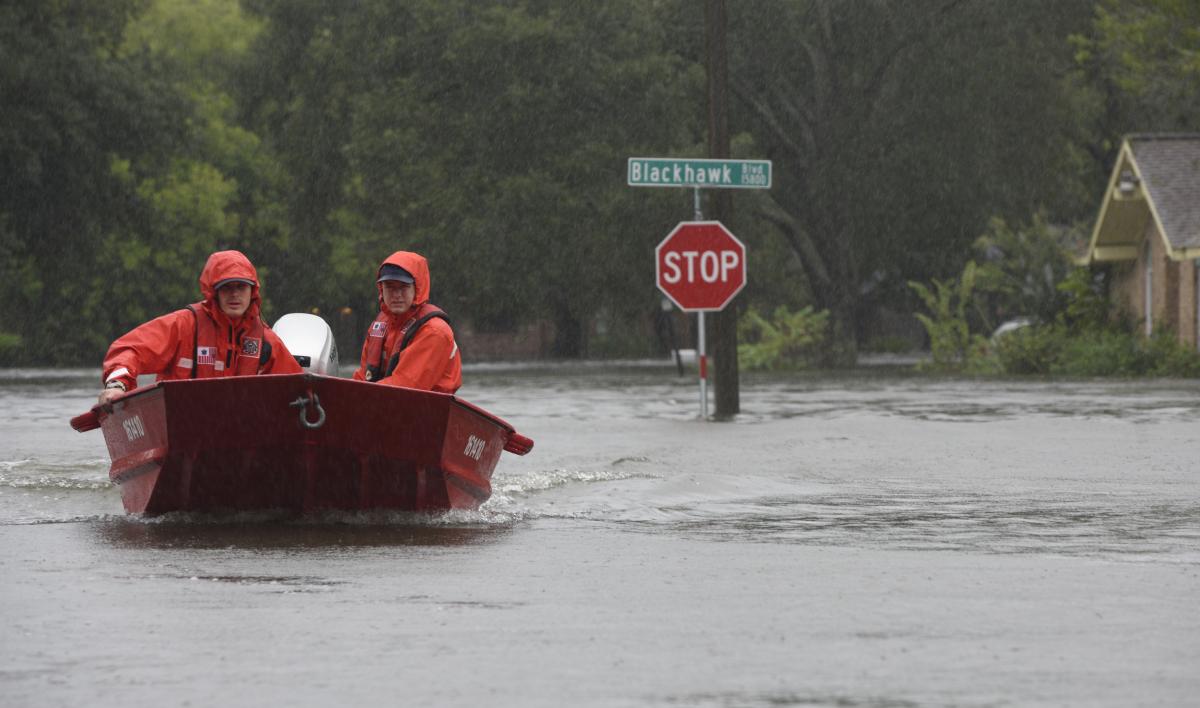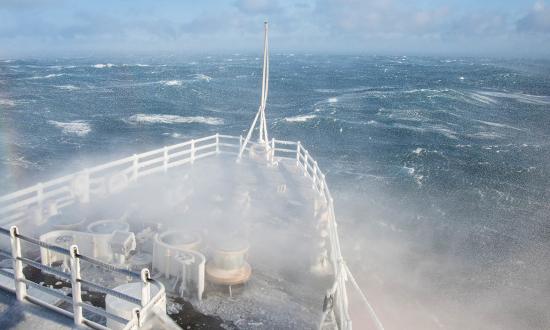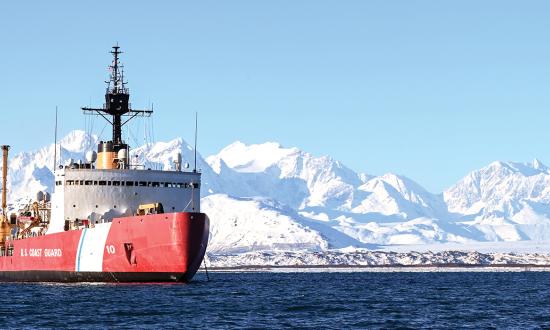“I am not a scientist. I can read what scientists say, but I’m in the world of consequence management. . . . So it is clear to me that there are changes happening, but I have to deal with the consequences of that.” —Admiral Robert Papp Jr., 24th Commandant of the U.S. Coast Guard
The Coast Guard must be better prepared to respond to notable changes in the environment. Since 1900, global average temperature has increased by about 1.8 degrees Fahrenheit. Along with this temperature increase, the U.S. Global Change Research Program (USGCRP) reports that global average sea level has risen almost seven to eight inches, the frequency of high tide flooding has amplified by a factor of five to ten, and Atlantic hurricane activity has increased. Looking toward the end of this century, average sea levels are projected to rise to one to four feet, severe flooding is expected to continue, and hurricane rainfall and intensity are projected to increase. As the primary federal agency for all coastal flooding and hurricane response operations, the Coast Guard must question if it is adequately prepared for the increase in these climate-related events.
Maintaining a workforce of only 56,000 active duty, reserve, and civilian employees and a budget of roughly $12 billion, the Coast Guard ensures the security of a 4.5 million square mile exclusive economic zone and 95,000 miles of shoreline. The Coast Guard performs 11 statutory missions including search and rescue (SAR), marine environmental protection, and aids to navigation. In addition, it handles catastrophes such as oil spills. Changes to global climate and the corresponding increase in flooding and hurricane activity suggest the Coast Guard could see effects on nearly every mission. To best prepare, the Coast Guard should increase its force planning construct capabilities, as well as provide a commensurate increase in workforce, specialized training, and funding to support it.
Force Planning
According to the force planning construct—detailed in the Western Hemisphere Strategy—“The Coast Guard will plan and resource the appropriate levels of staffing for a broad array of contingencies. The Coast Guard will also prepare to address future risks by ensuring the capability and capacity to respond simultaneously to one nationally significant response operation, one regional surge operation in a district, and highest priority response operations locally.” More specifically, the Coast Guard must have the capability to sustain incident-response operations for two of the most complex incidents for up to three months. While this construct does account for simultaneous incidents, it only accounts for two major ones and ensures the capability to respond for a maximum of three months to each. In a warming world, this assumption will be challenged.
The force planning construct has already been tested by severe hurricane activity. In 2005, Hurricanes Emily, Katrina, Rita, and Wilma set the record for the most Category 5 storms in a single season. More recently, in 2017, Hurricane Harvey produced more rainfall than any other known storm in the continental United States, and Hurricane Irma broke the record for the longest time with sustained winds of 185 miles per hour. USGCRP reports that the 2017 hurricane season was the costliest one on record after reaching $306.2 billion in damages, followed by the 2005 season with more than $214.8 billion in damages. Consequently, the 2005 and 2017 hurricane seasons both required unprecedented Coast Guard response operations. In 2005, then–Commandant of the Coast Guard Admiral Thomas Collins told Congress the service conducted 33,544 rescues during Hurricane Katrina—seven years’ worth of SAR in two weeks. The list goes on.
These two hurricane seasons are benchmarks when evaluating the Coast Guard’s force planning construct against future climate-related requirements. Although the service exceeded all expectations during 2005 and 2017, its efforts imposed considerable risks on overall readiness. During Hurricane Katrina, more than one-third of all Coast Guard aviation assets deployed to the Gulf Coast, and the service incurred risk to its nationwide readiness posture throughout all 50 states. Canadian forces covered the Northwest Atlantic SAR mission, all aviation training was deferred until after the response, and forces performing counterdrug, fisheries enforcement, and migrant interdiction operations in the Caribbean and Florida Straits were reduced. Again in 2017, the Coast Guard assumed similar risks. According to Rear Admiral Paul Thomas, Coast Guard District Eight commander during the 2017 response, “The Coast Guard endured risk exposure across all eleven missions with service-wide impacts to training, personnel readiness, and maintenance of equipment.”
Making Improvements
To be ready for more and more persistent incidents, the Coast Guard should, first, increase the capabilities of its force planning construct to account for longer-duration responses. According to USGCRP, the projected increase in North Atlantic hurricane intensity could increase the probability of extreme flooding in most U.S. Atlantic and Gulf Coast states beyond what would be projected based on sea level rise alone. Admiral Collins highlighted the Coast Guard’s challenges in 2005. According to Collins, “While the Coast Guard is well-positioned for immediate and effective first response, our limited ‘bench strength’ makes it impossible to sustain these operations for an extended period of time.” Furthermore, the inadequacy of planning for a three-month response capability was shown during the 2017 hurricane season when Coast Guard personnel directly supported response efforts from 23 August 2017 to 31 March 2018—more than seven months of response operations, twice the planned-for time.
The Coast Guard also should increase the force planning construct’s capabilities to allow for response to more than two major simultaneous incidents. During the 2017 hurricane season, the Coast Guard responded to three major hurricanes within just six weeks. While the 2017 hurricane season remains unusual, multiple major hurricanes will become more commonplace as the world continues to warm. The National Research Council’s 2013 Climate and Social Stress report suggests that event clusters such as multiple major hurricanes, could be increasing in likelihood more rapidly than the single events themselves. The event clusters concept is supported by Eberhard Faust and Mark Bove, who note: “High activity periods reveal a temporal structure of high season-to-season variability with occasional extremely active seasons which are characterized by a cluster of very intense storms.” In other words, more than two simultaneous events may soon become the norm.
Workforce
To best support a more capable force planning construct, the Coast Guard will need to make some notable changes. First, the service should increase the size of its workforce. It typically responds to natural disasters with a combination of active duty, reserve, and civilian employees. During the peak response period for Hurricane Katrina, the Coast Guard had approximately 5,600 personnel in the Gulf Coast region, of whom 5,300 were active-duty, reserve, or civilian employees, with the balance being Auxiliarists—nearly 10 percent of its 54,100-person workforce at the time. This forced the service to accept considerable risks.
According to Admiral Collins, “The Coast Guard is a small service. With only 39,000 personnel on active duty, a major natural disaster severely strains our capabilities and requires a delicate balancing of risk in other geographic and mission areas.” Rear Admiral Thomas expressed similar sentiments in 2017, when he noted, “The Coast Guard is small in comparison to the other Armed Services. . . . Residual risk was spread across the Coast Guard, with a keen eye towards meeting minimal mission standards in most, but not all, locations.” In short, other missions suffered because of the size of the service.
Specialized Training
To best support a more capable force planning construct, the Coast Guard should provide its workforce with more specialized training. Over the past 15 years, the scope of SAR following catastrophic incidents has grown rapidly. This new SAR role requires specialized training, experience, and competencies that the Coast Guard does not maintain, despite SAR being a primary mission. This capability gap was highlighted through interviews of Coast Guard rescue swimmers following response to Hurricane Harvey. According to Aviation Survival Technician Second Class Sam Knoeppel, many of the rescue swimmers used chainsaws to remove people from their attics, tools Coast Guard personnel typically do not use. Knoeppel said: “We got a really quick brief on how to operate them safely, and basically it was up to us if we wanted to take them and use them.” He also admitted, “We were doing 150- to 200-foot hoists over land, every hoist, which is not something I’ve done.” It is a strength of the Coast Guard that Knoeppel and others could adapt so quickly, but as catastrophic incident SAR events become more frequent, so should specialized training.
Funding
Finally, to best support a more capable force planning construct, the Coast Guard should seek additional funding from Congress. Historically, the Coast Guard has encountered numerous funding struggles. The Budget Control Act of 2011 (also known as sequestration) reduced Coast Guard spending. According to Admiral Karl Schultz, current Commandant of the Coast Guard: “When measuring buying power from 2012 to 2019, the service’s bills increased by over $300 million without receiving additional funds to compensate.” Shultz says this directly affected readiness and estimates the service lost the equivalent of two major cutters and seven helicopters in 2018 from the loss of purchasing power, unplanned maintenance, and supply shortages.
Hurricane response has only exacerbated the Coast Guard’s budget woes. After the 2017 season, the Coast Guard faced a $914 million shortfall, which created a backlog of ship and aircraft maintenance as well as repairs for hangars and other facilities damaged by the storms. As a result, Congress provided the Coast Guard with $835 million in supplemental funding in 2018. According to the Congressional Research Service, between 2005 and 2009, Congress provided the Coast Guard with $487 million in supplemental funding, to account for the effects of Hurricanes Katrina, Rita, Wilma, Gustav, and Ike. Again in 2019, Congress continued the practice with a $526 million supplemental appropriation, or 4.4 percent above its total 2019 budget, to account for the 2018 storms. As storm activity has continued to accelerate, so too have the allotments of storm-related supplemental funding. If one thing is apparent from these statistics, it is that, historically, Coast Guard funding levels have not accounted for an increase in storm activity and the service’s subsequent response efforts. Without additional funding from Congress, Coast Guard readiness will continue to erode in a warming world.
Average sea levels, flooding events, and Atlantic hurricane activity have all increased over the past century. In the coming decades, these changes are expected to continue, and the Coast Guard must be prepared. Although the Coast Guard has performed admirably, it cannot continue to risk recapitalization, training, and readiness in future storm seasons. To prepare for future demands, the Coast Guard’s force planning construct should better account for contingencies that necessitate longer response durations and more than two major simultaneous response efforts. This will require an increase in the size of the workforce, specialized training in catastrophic incident SAR, and additional funding from Congress. Only after these steps are taken will the Coast Guard be able to fulfill its motto of being “Always Ready.”






